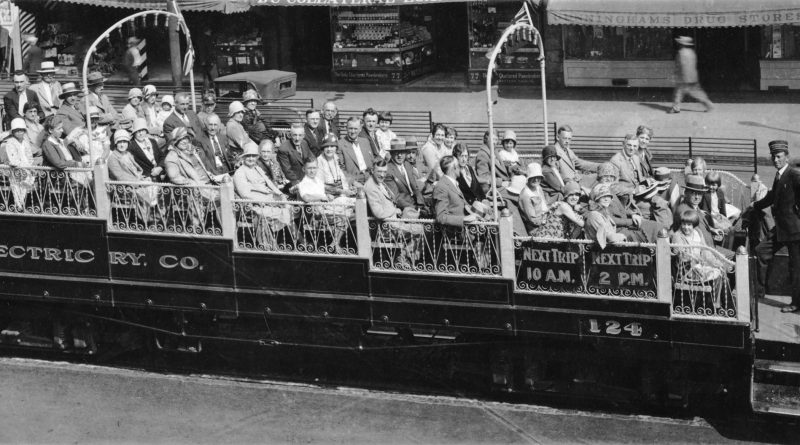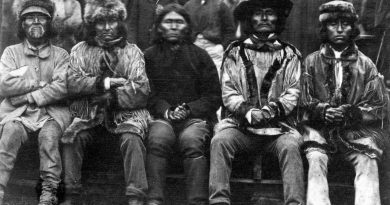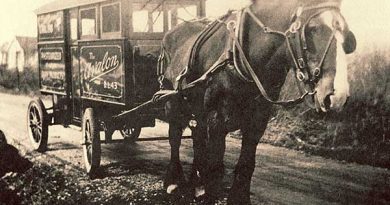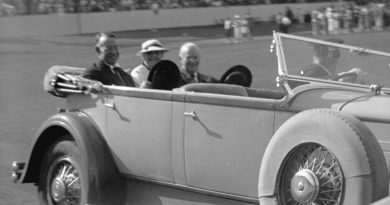1939
Above: B.C. Electric Railway Company Observation Car, 1929, “Teddy” Lyons, conductor
[Image: Vancouver City Archives AM336-S3-2-: CVA 677-81]
*****************************************
You’ll note that these years include events listed under “Also in . . .” These are events for which we don’t have a specific date. If YOU know the specific date of an event shown there, please notify us . . . and cite the source! Many thanks!
*****************************************
January 11 B.C.’s Premier Pattullo, in Ottawa, told the federal government B.C. wouldn’t object to the “infiltration” of a small number of European refugees into Canada “if they can be readily absorbed.”He is, said the Sun, definitely opposed to any large movement.
January 12 Hedley S. Hipwell was elected president of the Kiwanis Club for 1939.
January 13 Page 1 headline in the Sun: Two Guns to be Placed at First Narrows.
January 14 Deputy-Chief Grundy of the Vancouver Police Department was reported to have been demoted in a ‘shakeup’ of the force. The Sun reported “War Declared on Vice.” The “absolute suppression of prostitution” was to be undertaken immediately.
January 31 The Harlem Globetrotters were visiting Vancouver. (The Sun byline on that story: Pat Slattery. He would become locally well known in the future for his articles on men’s fashion.)
Also January 31 E.H. Grubbe retired from the Bank of Montreal at Main and Hastings after 45 years in banking, 40 of them in BC. He was succeeded as manager of that branch by H.S. Hase.
January 23 Sculptor Charles Marega’s lions were installed at the south approach to Lions Gate Bridge. Marega was unhappy with the work: he had wanted the lions to be of bronze, but budget restrictions forced him to use concrete.
February 11 UBC held an Open House.
February 24 The first fireman’s dance was held in Burnaby. Admission was $1 a couple.
March 1 The official inauguration of airmail service Montreal-Toronto-Vancouver.
March 6 A vehicle testing station opened. Vancouver Mayor Lyle Telford drove the first car through.
March 24 Sculptor Charles Marega died, just two months after his most famous work, the Lions Gate Bridge lions, were installed. He had just finished teaching a class at the Vancouver School of Art and collapsed while putting on his coat to go home. He was 68. “No one,” historian Peggy Imredy has written, “has left such an enduring and visible record of his life in Vancouver. As was said at his funeral, ‘There is no need to build him a monument—because of his sculpture he will never be forgotten’.” Among his other work: the Joe Fortes fountain, the Edward VII fountain by the Art Gallery, the busts of Burrard and Vancouver on the Burrard Street Bridge, the statue of Vancouver at city hall and the bust of David Oppenheimer near the Parks Board offices.” For more on Marega, see Peggy Imredy’s longer article here.
May 24 The CPR bade a musical farewell to the second Hotel Vancouver as . . .
Also on May 24 The present Hotel Vancouver opened. Writes architectural historian Harold Kalman on Canada’s chateau-like hotels, “Inspired by the picturesque castles of France and Scotland, the steep-roofed hotels cater to our fantasies of palatial living. Vancouver’s version, resplendent in its gargoyles, Renaissance detail, and fine relief sculpture, was built by the CNR. Delayed by the Depression, it was rushed to completion in 1939 for the Royal Visit of King George VI and Queen Elizabeth. The rival CPR co-operatively closed its own, earlier, Hotel Vancouver (two blocks east), lent the name, and entered into a joint management contract.”
While visiting here, the King and Queen stayed overnight at the new Hotel Vancouver.
May 26 Their Majesties, King George VI and Queen Elizabeth officially opened the Lions Gate Bridge.
May 27 A Chinatown street dance celebrated the visit of the royal couple.
Early June Carson Manzer, who played cornet in one of the Vancouver boys’ bands that Arthur Delamont conducted, travelled to Europe with the band. He has written a short and lively description of that trip, which you can read here. They had to leave Europe sooner than expected: war clouds were gathering. (The “Mister D” referred to is Delamont.)
July 3 The second charter granted to a credit union in British Columbia, researcher Bruce Constantineau writes, was to the Amalgamated Civil Servants Credit Union of Vancouver. (It was renamed Vanfed before it became part of Burnaby Credit Union in 1982. That organization was renamed Harbour Savings in 1985 before it was merged with North Shore Credit Union in 1986.) The first B.C. charter, by the way, was awarded to Powell River Credit Union on June 9, 1939 and that credit union still exists under that name. The already-existing Common Good Credit Unit, formed in 1936, was third.
July 4 Lou Gehrig’s “luckiest man on the face of the earth” speech at Yankee Stadium.
June 5 From the Vancouver Sun: JOE GONSALVES, PIONEER, DEAD
“Joe Gonsalves, 82, who came to Vancouver when it was known as Gastown 65 years ago, died Saturday night [June 3] in St. Paul’s Hospital, to which he was admitted several weeks ago.
“Mr. Gonsalves’ home was at Pender Harbor, where he had lived for the last 35 years. He came to Vancouver in 1874, when he was about 17. At 12 he had left his home on the Island of Madeira after he had prevailed on a sea captain to let him travel on his ship.
“For several years he was a squatter in Stanley Park and his five daughters and one son were all born at Brockton Point. As he lay in the hospital, his mind still alert, despite his age, he recalled early days of Vancouver and the British Columbia coast.
“Requiem mass will be sung for Mr. Gonsalves in Holy Rosary Cathedral at 9 a.m. Wednesday. Burial will be in Ocean View Park. Surviving is one son, Alfred, and five sisters [Note: they mean daughters], Mrs. G. Duncan, Mrs. E. J. Myers, Mrs. T. Dames, Mrs. N. McDonald and Miss Theresa Gonsalves.
August 3 Radio telephones were installed in Vancouver’s police cars.
August 26 Local militia stand by guns at First Narrows in North Vancouver as world war threatens.
September 1 Hitler invaded Poland. The Second World War had begun.
September 3 Britain and France declared war on Germany.
September 10 Canada declared war on Germany. In Vancouver, German-speaking citizens pledged their loyalty to Canada at a mass meeting in Moose Hall.
September Vancouver’s harbor was put under the control of the Royal Canadian Navy. All shipping passing into the harbor must stop and report to naval launches.
September Granville Island, the industrial heart of the city, began working around the clock, producing defence equipment such as anti-torpedo nets, minesweeping equipment and rigging ropes for the merchant fleet. And, for the first time, women were hired at the factories.
October 11 Dr. Leonard Klinck, UBC President, opened the city’s first public aquarium at the old English Bay bathhouse. The star was “Oscar the Octopus.” Manager of the aquarium was an American named Ivar Haglund, who later moved to Seattle and opened a restaurant called Ivar’s Acres of Clams. (A restaurant, eh? Anyone here seen Oscar?) The facility closed in 1956.
October 18 A committee of prominent men from the Lower Mainland approached Surrey council, and successfully petitioned to rename the Peace Arch Highway. The new name: the King George VI Highway.
November 18 Author Margaret Atwood was born.
November 21 A 50th anniversary banquet was held to celebrate craft unionism in the Lower Mainland.
December 2 Vancouver welcomed its first dial telephones.
Mid-December The first contingent of the Canadian Active Service Force left for Europe. The second contingent will leave January 2, 1940. Wartime security measures forbid an indication of where they left from.
December 18 Winston Churchill, First Lord of the Admiralty, spoke to the world today in a broadcast from London. “The First Contingent of the Canadian Expeditionary Force, safely escorted across the Atlantic by the main battle fleet, was disembarked at a British port.” Churchill revealed the progress of the Canadian soldiers in the course of his report on the sinking of the German battleship Graf Spee.
Also in 1939
The Boeing plant on Sea Island was built for the production of Canso and Catalina and later B-29 superfortress aircraft. At the peak of production it employed 6,000 people. See this website.
UBC students provided nearly $80,000 to build the university’s first student union building, a memorial to the late Dean of Applied Science, Reginald W. Brock and his wife, killed in a 1935 airplane accident. Brock Memorial Hall originally housed a main lounge, snack bar, Alma Mater Society offices, club rooms, a committee room seating 200 people, and general offices including the Mildred Brock Room for women students.
Eric Hamber received an honorary doctorate of laws from UBC.
Steelhead Lodge in Coquitlam, a secluded getaway for Hollywood stars, was built by Canadian movie stunt man Karl Jacobs. Some of the present streets in the River Springs neighborhood were named for famous visitors: Gable, Novak and Flynn. (We’d like more detail on this item: Kim Novak didn’t get into movies until the 1950s.)
One of the odder railway stories in B.C. history happened this year. First, you need to know that one local result of the Great Depression was that Grouse Mountain had become home to a small colony of squatters. They built a small village of log cabins up there—nearly 100 of them—and that little settlement, as the economy improved over time, began turning into what the locals called “Ski Village.” Enter a fellow named Kent Ford, who proposed a sprocket railway from Mosquito Creek up to the village.
Ford’s proposal ran into a vexing problem: with exquisitely inconvenient timing, the Second World War started after construction had begun and Ford was unable to get enough steel. He must have been a formidable optimist: without even pausing for breath he continued to build his railway —with one track of steel, the other of wood. It didn’t work.
Curiously enough, an attempt nearly 30 years earlier to build a railway up Grouse had foundered for exactly the same reason: a lack of steel because of a world war!
Steveston voted to stay “dry.”
Soon after the start of World War II, Richmond’s Japanese residents, among others, raised money for the National Defence fund.
A herring reduction plant was installed in the Gulf of Georgia Cannery to produce fish meal and fish oil, used for many industrial and agricultural purposes.
The B.C. Electric Railway ended its daily milk run for Fraser Valley farmers.
The North Vancouver Youth Band was founded.
George Adams was a contractor who built the Carnegie Library at Main and Hastings, early parts of the Vancouver General Hospital, and the W.H. Malkin warehouse, now the Old Spaghetti Factory. He bought lot 492 at Tunstall Bay on Bowen Island, built a house and moved there with his family this year. The island’s Adams Road is named for him.
Appraised at $75,000 in 1920, “Glen Brae,” the William Lamont Tate mansion at 1690 Matthews, sold this year for $7,500. Today, it’s the children’s hospice Canuck Place.
Fairacres, a handsome twin-gabled Tudor Revival house, was built in Burnaby in 1910 for Grace and Henry Ceperley, a Michigan heiress and a Vancouver realtor. In 1939 the brothers of the Benedictine Order moved in. (In 1955 they would move to their present home at Westminster Abbey, Mission. Today, Fairacres is the Burnaby Art Gallery.)
James Lyle Telford, 50, became mayor of Vancouver, succeeding George Miller. “A newcomer to the civic political arena,” Donna Jean McKinnon writes, “Lyle Telford was, however, no stranger to politics, having represented the CCF in the provincial legislature. In this election he offered ‘help for the forgotten man,’ tapping into the frustration of the voters after nearly a decade of poverty. Once elected, Telford resigned from the CCF because he felt civic office should be free of party politics. Despite his obvious working class following, Telford won the mayoralty with fewer than 2,000 votes in a campaign with six other candidates.”
The spread of venereal disease prompted police chief W.W. Foster to launch another crackdown by his ‘morality squad.’
D. Mackay became chief constable of the Vancouver Police Department, succeeding W.W. Foster.
1939 was a big year for local Scots. “More than 700 Scots crowded into the Commodore,” wrote Kevin Griffin in The Greater Vancouver Book, “for the annual feast [Robert Burns Night] where they heard the haggis—a sheep’s stomach stuffed with minced mutton, oatmeal and spices—piped into the hall and addressed with the words of Burns: ‘Fair fa’ your honest sonsie face/Great chieftain o’ the pudden race . . .’ Behind the head table stood a statue of Burns flanked by the Union Jack and the flag of St. Andrew.”
The Nazi invasion of Czechoslovakia caused a great exodus—political leaders, businesspeople, professionals, and intellectuals fled. Theodor, Otto, Leon, and Walter Koerner were among those who came to British Columbia. With their background in forestry, the four brothers formed the Alaska Pine and Cellulose Company. It was Walter Koerner’s idea to rename western hemlock, which had not been a popular wood for construction, as “Alaska Pine.” Read an interesting profile of Walter Koerner here.
St. Peter’s Catholic Church at the corner of Royal Avenue and Fourth Street in New Westminster was built this year in the California missions style. The church has statues that survive from the old St. Peter’s Cathedral (built in 1886 on Blackwood Street, damaged beyond repair in 1934): the Blessed Mother and Child, St. Joseph, and Peter. The crucifix over the altar is also from the old cathedral.
North Shore Neighborhood House opened.
The Western Canadian Lumber Worker, a monthly publication of the International Woodworkers of America, began publishing.
The Empress of Japan II, a trans-Pacific liner owned and operated by Canadian Pacific, and sailing out of Vancouver since late 1930, was requisitioned as a troop ship. Her name was changed to Empress of Scotland. After the war she returned to CPR service in the North Atlantic, then was sold in 1958 and renamed Hanseatic. After fire damage she was scrapped in 1966.
Rob Morris and Leonard McCann, historians, write that the Prince Robert, built in 1930 for the Canadian National Railway’s Vancouver-to-Alaska cruise service, carried the King and Queen from Victoria to Vancouver this year and then was converted by the Royal Canadian Navy to an armed merchant cruiser. (She would seize the German freighter Weser off Manzanillo in 1940 and bring her to Esquimalt as a prize of war, then continue her wartime service around the world until 1945.)
The discount store arrived. Selling ends of lines, overstocked inventory and bankruptcy close-outs, the first Army & Navy Store opened in 1919 at 44 West Hastings and moved to its present 300 West Hastings location this year.
Queen Elizabeth Park was named for the Queen Mother. Once a rock quarry, and sitting atop an extinct volcano, this park is a beauty spot, a riot of color, with flowers, shrubs, rare trees, and more on every side. The Bloedel Conservatory, Seasons Restaurant and so on, were added in later years.
The 2850 Hudson locomotive that drew King George VI and Queen Elizabeth across Canada this year so impressed the King with its power that he gave his approval for these locomotives to carry the “Royal” designation. Hence, the “Royal Hudsons.” Incidentally, 2850 carried the royal couple on CPR lines from east to west, then CNR lines on the return voyage.
The Van Tan nudist club began, the first such club in the lower mainland.




